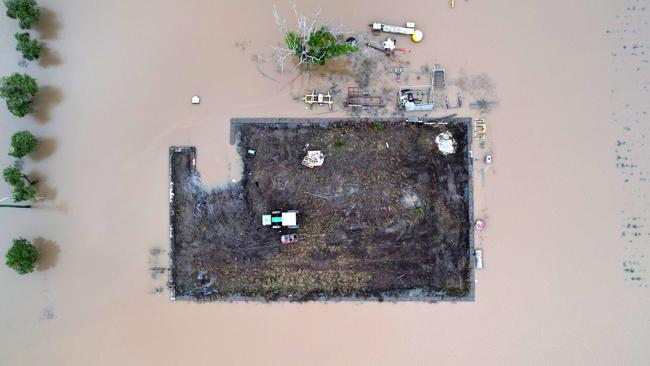NSW floods: Long, slow recovery for farmers who lost crops, machinery and homes
Months after floods ripped through the NSW north coast, farmers are still reeling from damage to property and machinery.
Three months on from record floods in the NSW Northern Rivers region, growers are still reeling from lost crops, machinery and destroyed homes.
Sugarcane and soyabean farmers have been particularly hard hit, and there is likely to be a sharp drop in cereal crops planted in the region during winter, growers say.
McGregor Gourlay senior agronomist Steve Leeson said he sees his role now as helping his clients get through each day.

“My job is to sell stuff, but I’m not really selling much now. All I’m basically doing is trying to keep (clients’) spirits up,” he said.
Mr Leeson normally spends his time travelling between properties in the Clarence, Richmond and Tweed valleys, selling agricultural products to clients growing sugarcane, soyabeans and rice.
Mr Leeson’s clients, who farm the rich soils of low-lying coastal areas and flood plains, were some of the hardest hit when record floods swept through the region in February and March.
Only six of his 58 clients have houses that weren’t affected by floodwater, and just four didn’t lose their farming machinery, he said.
Growers in the region face a long, slow recovery.
Soyabeans, traditionally grown as a fallow crop by sugarcane farmers, were due to be harvested last month, but 95 per cent of crops in the region were wiped out in the floods and subsequent heavy rain, according to the North Coast Oilseed Growers Association.
The sugarcane harvest, which traditionally starts in June, is expected to be held up by lost machinery, inaccessible fields, and canes covered in dirt and mud, Mr Leeson said.
Sunshine Sugar’s Broadwater mill suffered extensive damage in the floods, and is not expected to be fully operational until the end of August, while repairs are underway at the company’s Condong and Harwood mills to make them operational by the end of June.
“For some farmers, I’m noticing that it’s really starting to hit home now, and some of them are a bit lost as to what they’re going to do,” Mr Leeson said.

DROP IN WINTER PLANTINGS
North Coast Oilseed Growers Association president and Soy Australia chairman Paul Fleming
said he expected a drop in winter crop plantings in the region this year.
Mr Fleming said many growers had only just been able to access their paddocks this week after flooding in February and March, and would be weighing up whether the risk of planting a late winter crop was worth it.
“This week is the first week since March that it’s been dry enough up for people to start thinking about accessing paddocks,” he said.
“Usually by now we’d be planting wheat and barley or oats for hay, but we’ve just about given up. It’s getting a little bit late to plant a winter crop,” Mr Fleming said.
The nearest weather station to his property, in Casino, recorded falls of 1189mm so far this year, almost double the annual average of 590mm.
Winter cereal crops are normally a small part of an annual cropping program for Mr Fleming, who also grows soyabeans, rice, corn and sugarcane. This year, if he can plant them, they could make up the majority of his income.
Mr Fleming’s summer soyabean crop was completely wiped out by rain and flooding earlier this year, and his rice was heavily downgraded.
“We’ve got a little bit of hope that we might put something late in for winter to get a bit of income coming in the next 12 months. Otherwise it’s going to be at least this time next year before we harvest our soyabeans again,” he said.
According to the latest estimates from Rabobank, the area planted to crops in NSW is expected to decline sightly by 2 per cent this year compared to last year.

MACHINERY LOSSES SLOWING RECOVERY
Hundreds of tractors have been written off across the Northern Rivers due to flood damage, and farmers are facing long wait times to import new gear, Mr Fleming said.
“The waiting times for some new tractors have blown out to two years. Unless what you want is in the country, you will probably be waiting at least nine months.
“(Insurance) can replace machinery, but unless you can actually plant the next crop, then you can’t start making money again,” he said.
“It’s going to make for very tough times going forward.”





